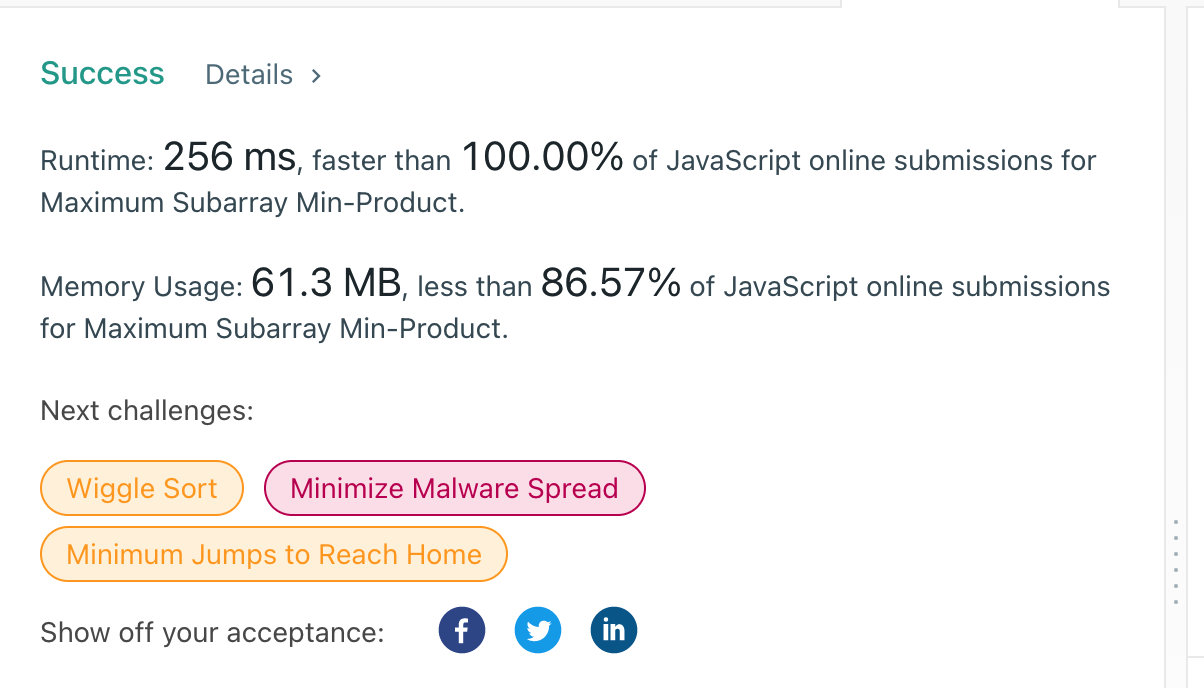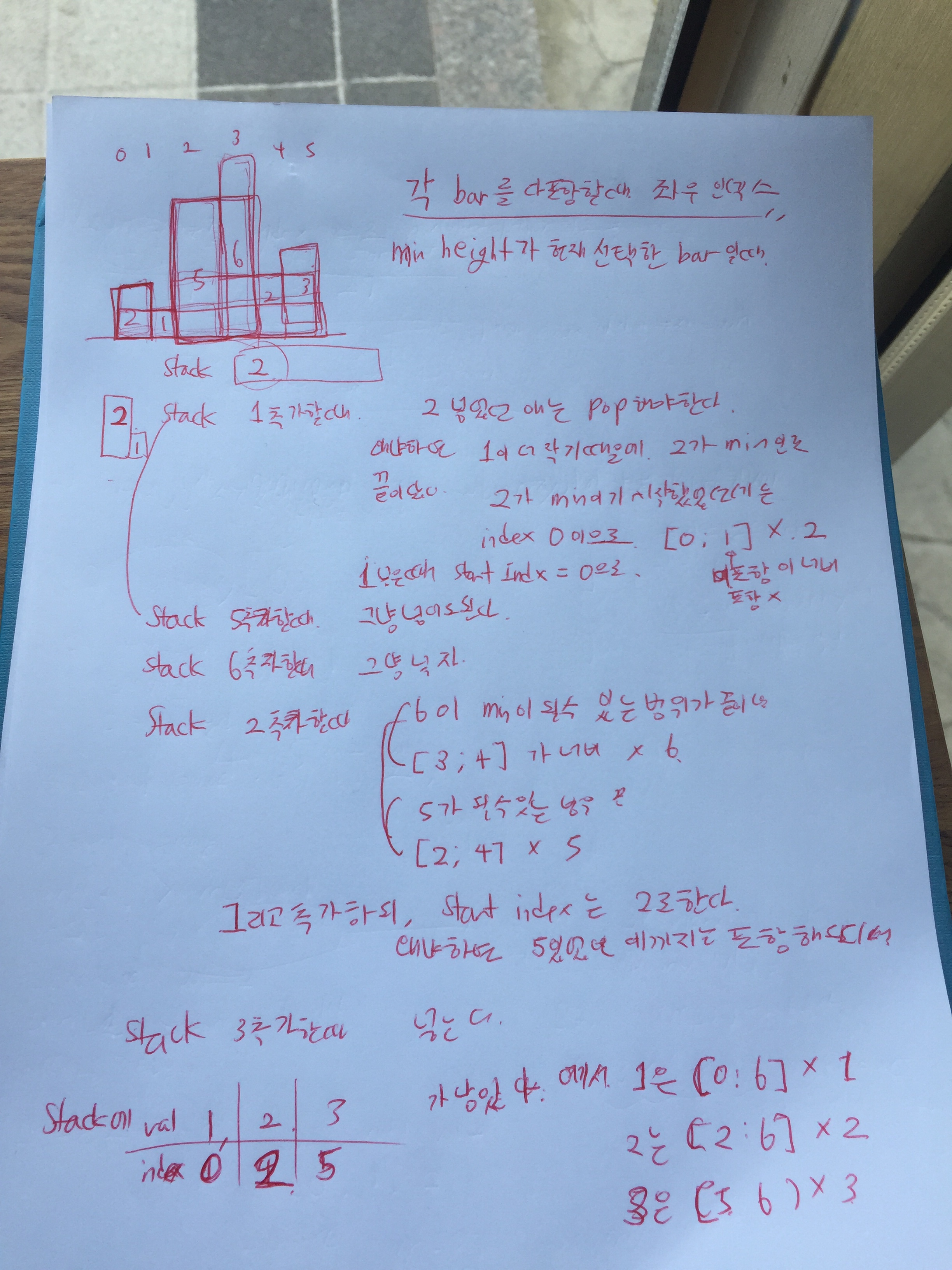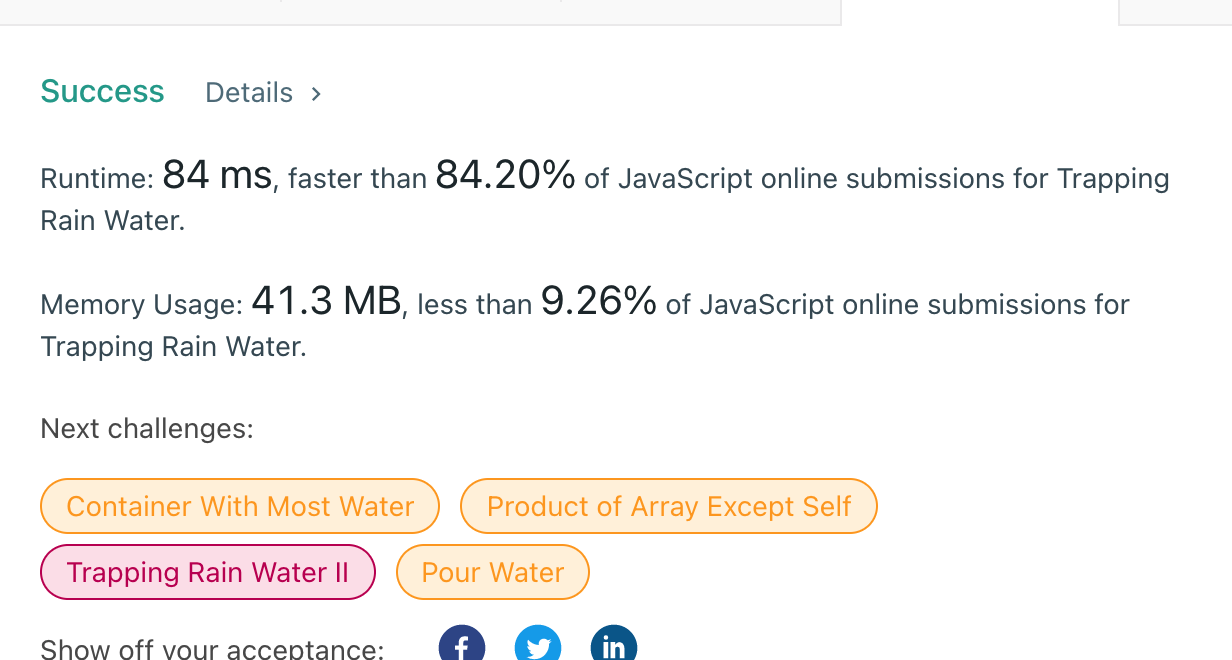-
두시간 알고리즘 - 3일차, StackWeb Dev/2. JS 알고리즘 2021. 5. 25. 12:05728x90
Stack이 정말 활용도가 높다는 사실을 새삼깨닫고, 오늘은 stack을 심화해서 응용하는 문제들을 풀어보려고 한다. 2시간을 정해두고 알고리즘을 한지 3일이 되었는데, 이제 내일까지만하면 작심삼일은 깨는거다.
1. Maximum Subarray Min-Product: 1h28m53s55
https://leetcode.com/problems/maximum-subarray-min-product/
Maximum Subarray Min-Product - LeetCode
Level up your coding skills and quickly land a job. This is the best place to expand your knowledge and get prepared for your next interview.
leetcode.com
https://www.youtube.com/watch?v=YLesLbNkyjA&t=1166s
처음엔 하도 이해가 안되서 강사탓을 했지만, 내가 문제였다.

악필이지만 나름 필기 깨달음이 있었다. Stack을 통해서 현재 체크하는 값을 포함하는 가장큰 subarray 범위의 index를 구할 수 있다.
monotonous increasing stack을 이용해서, 각 값이 subarray의 최소값일수있도록 인덱스를 stack에 넣는 문제
문제자체는 저 해설을 보고 풀었는데, 문제는 JavaScript가 64비트를 지원하지 않고, 53비트까지 지원한다는 거다.
https://developer.mozilla.org/en-US/docs/Web/JavaScript/Reference/Global_Objects/BigInt
BigInt - JavaScript | MDN
BigInt is a built-in object whose constructor returns a bigint primitive — also called a BigInt value, or sometimes just a BigInt — to represent whole numbers larger than 2^53 - 1 (Number.MAX_SAFE_INTEGER), which is the largest number JavaScript can re
developer.mozilla.org
BigInt를 사용해줘야한다.
/** * @param {number[]} nums * @return {number} */ var maxSumMinProduct = function(nums) { const modulo = BigInt(Math.pow(10, 9) + 7); // index i부터 j까지의 sum = sum[j+1] - sum[i]; const sums = nums.reduce((acc, n, index) => { acc.push(acc[index] + n); return acc; }, [0]); const stack = []; // {index(시작), minValue} let answer = BigInt(0); for(let index = 0; index < nums.length; index++){ let lastIndex = index; while(stack.length > 0 && stack[stack.length-1].minValue > nums[index]){ // 현재 stack의 마지막의 value보다 현재 추가하려는 값이 작을때까지 반복 const comp = stack.pop(); lastIndex = comp.index; // comp.index부터, index까지가 comp의 minValue를 최솟값으로 가지는 subArray의 범위이다 const minProduct = BigInt(comp.minValue) * BigInt(sums[index] - sums[comp.index]); if(answer < minProduct){ answer = minProduct; } } stack.push({index: lastIndex, minValue: nums[index]}); } // 남은 것들 처리 for(let i = stack.length-1; i>=0; i--){ const comp = stack[i]; const minProduct = BigInt(comp.minValue) * BigInt(sums[nums.length] - sums[comp.index]); if(answer < minProduct){ answer = minProduct; } } return answer % modulo; };
자바스크립트는 53비트까지 지원하지... 하는것을 다시 새길수 있었던 시간. prefix sum 부분도 BigInt 화해줘야하나했는데 문제조건에서 곱하더라도 64비트 미만이라고 보장을 해줘서 sum이 53비트를 넘지는 않겠구나하고 minProduct하는 부분만 BigInt처리를 해주었다. 숫자랑 섞이면 안된다는게 좀 낯설긴해서 다음에 다시 다루어 봐야할 type같다.
2. 84. Largest Rectangle in Histogram: 21m01s58
https://leetcode.com/problems/largest-rectangle-in-histogram/
Largest Rectangle in Histogram - LeetCode
Level up your coding skills and quickly land a job. This is the best place to expand your knowledge and get prepared for your next interview.
leetcode.com
Stack을 통해서 히스토그램의 최대 직사각형을 구하는 문제는 굉장히 유명하다고 하는데, 제대로 이해해본적이 없어서 이번에 다시 시도해보았다. 이번엔 내 머리가 이해해주길.
https://www.youtube.com/watch?v=zx5Sw9130L0
/** * @param {number[]} heights * @return {number} */ var largestRectangleArea = function(heights) { const stack = []; let answer = 0; for(let i = 0; i < heights.length; i++){ let newIndex = i; while(stack.length > 0 && stack[stack.length - 1].height > heights[i]){ const { startIndex, height } = stack.pop(); newIndex = startIndex; const area = (i - startIndex) * height; if(answer < area){ answer = area; } } stack.push({startIndex: newIndex, height: heights[i]}); } for(let i = stack.length - 1; i >= 0; i--){ const { startIndex, height } = stack.pop(); const area = (heights.length - startIndex) * height; if(answer < area){ answer = area; } } return answer; };1번문제를 이해했더니 2번은 똑같은 방식으로 풀수가 있었다.


3. Trapping rainwater: 46m31s49
https://leetcode.com/problems/trapping-rain-water/
Trapping Rain Water - LeetCode
Level up your coding skills and quickly land a job. This is the best place to expand your knowledge and get prepared for your next interview.
leetcode.com
/** * @param {number[]} height * @return {number} */ var trap = function(height) { const visited = new Set(); const stackR = []; // 오른쪽 방향으로 체크 let answer = 0; for(let i = 0; i < height.length; i++){ if(stackR.length === 0 && height[i] === 0){ continue; } if(stackR.length === 0){ stackR.push({index: i, height: height[i], sum: 0}); continue; } if(stackR[stackR.length - 1].height > height[i]){ stackR[stackR.length - 1].sum += (stackR[stackR.length - 1].height - height[i]); continue; } // 크거나 같을때 answer += stackR[stackR.length - 1].sum; visited.add(`${stackR[stackR.length - 1].index} ${i}`); stackR.pop(); stackR.push({index: i, height: height[i], sum: 0}); } // console.log(visited) const stackL = []; // 왼쪽 방향으로 체크 for(let i = height.length-1; i >= 0; i--){ if(stackL.length === 0 && height[i] === 0){ continue; } if(stackL.length === 0){ stackL.push({index: i, height: height[i], sum: 0}); continue; } if(stackL[stackL.length - 1].height > height[i]){ stackL[stackL.length - 1].sum += (stackL[stackL.length - 1].height - height[i]); continue; } // 크거나 같을때 if(!visited.has(`${i} ${stackL[stackL.length - 1].index}`)){ answer += stackL[stackL.length - 1].sum; } stackL.pop(); stackL.push({index: i, height: height[i], sum: 0}); } return answer; };스택 두개를 써서 오른쪽으로가면서 증가하는 방향일때 체크를 한번하고, 반대로 오면서 감소하는 방향일때 체크를 했다. set을 통해서 한번 체크했던 범위는 체크안하도록 뺏다. 메모리는 좀 많이 써브렀다. Stack을 reset해서 쓰면 더 적게 쓸것같다.

조금 나아지긴한다.

후기
드디어 물채우는 문제도 해결했다. 스택을 통해서 이런걸 할수있다니 하고 놀라운 시간이었다. 하나를 확실히 이해하고 나니까 두문제는 hard였는데도 풀수있었다.
'Web Dev > 2. JS 알고리즘' 카테고리의 다른 글
두시간 알고리즘 - 5일차, two pointer(2) (0) 2021.05.28 두시간 알고리즘 - 4일차, two pointer(1) (0) 2021.05.27 두시간 알고리즘 - 2일차, 오늘은 LeetCode Weekly Context 240 푼다 (0) 2021.05.25 두시간 알고리즘 - 1일차, 오늘은 LeetCode Weekly Context 241 푼다 (0) 2021.05.24 두시간 알고리즘 - 시작하기 (0) 2021.05.21